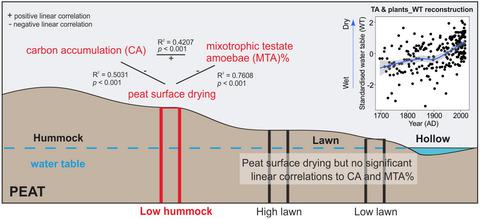当前位置:
X-MOL 学术
›
Glob. Change Biol.
›
论文详情
Our official English website, www.x-mol.net, welcomes your
feedback! (Note: you will need to create a separate account there.)
Decreased carbon accumulation feedback driven by climate-induced drying of two southern boreal bogs over recent centuries.
Global Change Biology ( IF 10.8 ) Pub Date : 2020-01-21 , DOI: 10.1111/gcb.15005 Hui Zhang 1, 2, 3 , Minna Väliranta 2, 3 , Sanna Piilo 2, 3 , Matthew J Amesbury 2, 4 , Marco A Aquino-López 5 , Thomas P Roland 4 , Susanna Salminen-Paatero 6 , Jussi Paatero 7 , Annalea Lohila 1, 7 , Eeva-Stiina Tuittila 8
Global Change Biology ( IF 10.8 ) Pub Date : 2020-01-21 , DOI: 10.1111/gcb.15005 Hui Zhang 1, 2, 3 , Minna Väliranta 2, 3 , Sanna Piilo 2, 3 , Matthew J Amesbury 2, 4 , Marco A Aquino-López 5 , Thomas P Roland 4 , Susanna Salminen-Paatero 6 , Jussi Paatero 7 , Annalea Lohila 1, 7 , Eeva-Stiina Tuittila 8
Affiliation

|
Northern boreal peatlands are important ecosystems in modulating global biogeochemical cycles, yet their biological communities and related carbon dynamics are highly sensitive to changes in climate. Despite this, the strength and recent direction of these feedbacks are still unclear. The response of boreal peatlands to climate warming has received relatively little attention compared with other northern peatland types, despite forming a large northern hemisphere-wide ecosystem. Here, we studied the response of two ombrotrophic boreal peatlands to climate variability over the last c. 200 years for which local meteorological data are available. We used remains from plants and testate amoebae to study historical changes in peatland biological communities. These data were supplemented by peat property (bulk density, carbon and nitrogen content), 14 C, 210 Pb and 137 Cs analyses and were used to infer changes in peatland hydrology and carbon dynamics. In total, six peat cores, three per study site, were studied that represent different microhabitats: low hummock (LH), high lawn and low lawn. The data show a consistent drying trend over recent centuries, represented mainly as a change from wet habitat Sphagnum spp. to dry habitat S. fuscum. Summer temperature and precipitation appeared to be important drivers shaping peatland community and surface moisture conditions. Data from the driest microhabitat studied, LH, revealed a clear and strong negative linear correlation (R2 = .5031; p < .001) between carbon accumulation rate and peat surface moisture conditions: under dry conditions, less carbon was accumulated. This suggests that at the dry end of the moisture gradient, availability of water regulates carbon accumulation. It can be further linked to the decreased abundance of mixotrophic testate amoebae under drier conditions (R2 = .4207; p < .001). Our study implies that if effective precipitation decreases in the future, the carbon uptake capacity of boreal bogs may be threatened.
中文翻译:

近几个世纪以来,气候引起的两个南部北方沼泽的干燥导致碳积累反馈减少。
北部北方泥炭地是调节全球生物地球化学循环的重要生态系统,但其生物群落和相关碳动态对气候变化高度敏感。尽管如此,这些反馈的强度和近期方向仍不清楚。尽管北方泥炭地形成了一个大型的北半球生态系统,但与其他北方泥炭地类型相比,北方泥炭地对气候变暖的反应相对较少受到关注。在这里,我们研究了过去一个世纪里两个营养型北方泥炭地对气候变化的响应。当地气象数据已有 200 年的历史。我们利用植物和有遗嘱变形虫的遗骸来研究泥炭地生物群落的历史变化。这些数据辅以泥炭特性(堆积密度、碳和氮含量)、14 C、210 Pb 和 137 Cs 分析,并用于推断泥炭地水文和碳动力学的变化。总共研究了六个泥炭核心,每个研究地点三个,代表不同的微生境:低丘(LH)、高草坪和低草坪。数据显示近几个世纪以来持续的干燥趋势,主要表现为泥炭藓属潮湿栖息地的变化。到干燥的栖息地 S. fucum。夏季温度和降水似乎是塑造泥炭地群落和地表湿度条件的重要驱动因素。来自所研究的最干燥的微生境 LH 的数据揭示了碳积累率与泥炭表面湿度条件之间存在明显且强烈的负线性相关性(R2 = .5031;p < .001):在干燥条件下,积累的碳较少。这表明在湿度梯度的干燥端,水的可用性调节碳积累。它可以进一步与干燥条件下混合营养型睾丸变形虫丰度的减少相关(R2 = .4207;p < .001)。我们的研究表明,如果未来有效降水量减少,北方沼泽的碳吸收能力可能会受到威胁。
更新日期:2020-02-21
中文翻译:

近几个世纪以来,气候引起的两个南部北方沼泽的干燥导致碳积累反馈减少。
北部北方泥炭地是调节全球生物地球化学循环的重要生态系统,但其生物群落和相关碳动态对气候变化高度敏感。尽管如此,这些反馈的强度和近期方向仍不清楚。尽管北方泥炭地形成了一个大型的北半球生态系统,但与其他北方泥炭地类型相比,北方泥炭地对气候变暖的反应相对较少受到关注。在这里,我们研究了过去一个世纪里两个营养型北方泥炭地对气候变化的响应。当地气象数据已有 200 年的历史。我们利用植物和有遗嘱变形虫的遗骸来研究泥炭地生物群落的历史变化。这些数据辅以泥炭特性(堆积密度、碳和氮含量)、14 C、210 Pb 和 137 Cs 分析,并用于推断泥炭地水文和碳动力学的变化。总共研究了六个泥炭核心,每个研究地点三个,代表不同的微生境:低丘(LH)、高草坪和低草坪。数据显示近几个世纪以来持续的干燥趋势,主要表现为泥炭藓属潮湿栖息地的变化。到干燥的栖息地 S. fucum。夏季温度和降水似乎是塑造泥炭地群落和地表湿度条件的重要驱动因素。来自所研究的最干燥的微生境 LH 的数据揭示了碳积累率与泥炭表面湿度条件之间存在明显且强烈的负线性相关性(R2 = .5031;p < .001):在干燥条件下,积累的碳较少。这表明在湿度梯度的干燥端,水的可用性调节碳积累。它可以进一步与干燥条件下混合营养型睾丸变形虫丰度的减少相关(R2 = .4207;p < .001)。我们的研究表明,如果未来有效降水量减少,北方沼泽的碳吸收能力可能会受到威胁。











































 京公网安备 11010802027423号
京公网安备 11010802027423号